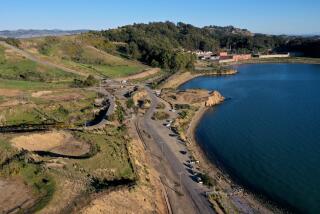New Help for the Bay
- Share via
A new day is coming for Santa Monica Bay-Thursday, to be precise. That is when the two-year Santa Monica Bay Project will be completed with the issuance of its report on the state of the bay and when, in effect, a new management program for the bay will start under the aegis of the Environmental Protection Agency’s National Estuary Program.
The exhaustive Santa Monica Bay Project report will indicate that pollution problems in the bay have been significantly reduced over time, but that much more needs to be known about the bay and its sources of pollution and the severity of any health threats posed by toxics and other pollutants to humans and sea life. A second volume addresses the complex question of how the bay is managed, and proposes actions to fill gaps between various agency responsibilities for the control of pollution and the monitoring of the health of the bay.
The report presents, in effect, a solid foundation on which to build the new bay structure under the National Estuary Program. Santa Monica Bay was incorporated into the program earlier this year under legislation sponsored by Rep. Mel Levine (D-Los Angeles). The program will provide a new coordinated management structure for the bay--sort of a cooperative planning program--and vital federal funds to finance the effort. Another boost for the bay came during the 1988 general election when Los Angeles voters overwhelmingly approved bond funds for the modernization of the city’s sewage-treatment and -disposal facilities. Periodic spills from the overtaxed sewage facilities have provided bay health scares in recent years.
The Santa Monica Bay Project was organized by Santa Monica City Council member Christine Reed as a response to controversy about the relative health of the bay, and was carried out by the Southern California Assn. of Governments with financial assistance from the cities of Los Angeles, Santa Monica, Culver City, Lawndale and Redondo Beach, Los Angeles County, the state and Chevron. The idea was to have a neutral assessment and evaluation of the plethora of scientific studies about the bay, and then to determine the effectiveness of the regulatory structure dealing with bay issues. As many as 25 federal, state and local agencies have some authority to control sources of pollution and to protect the public health and natural resources of the bay. Sometimes their authority overlaps, but there also have been major gaps between their monitoring and enforcement powers.
The start-up of the National Estuary Program in the bay should correct the major management problems identified by the project. Many of the local officials who participated in the Santa Monica Bay Project are expected to play key roles under the new estuary regime. Reed and her diverse steering committee deserve considerable credit for getting the new day for the bay off to a strong beginning.
More to Read
Sign up for Essential California
The most important California stories and recommendations in your inbox every morning.
You may occasionally receive promotional content from the Los Angeles Times.










